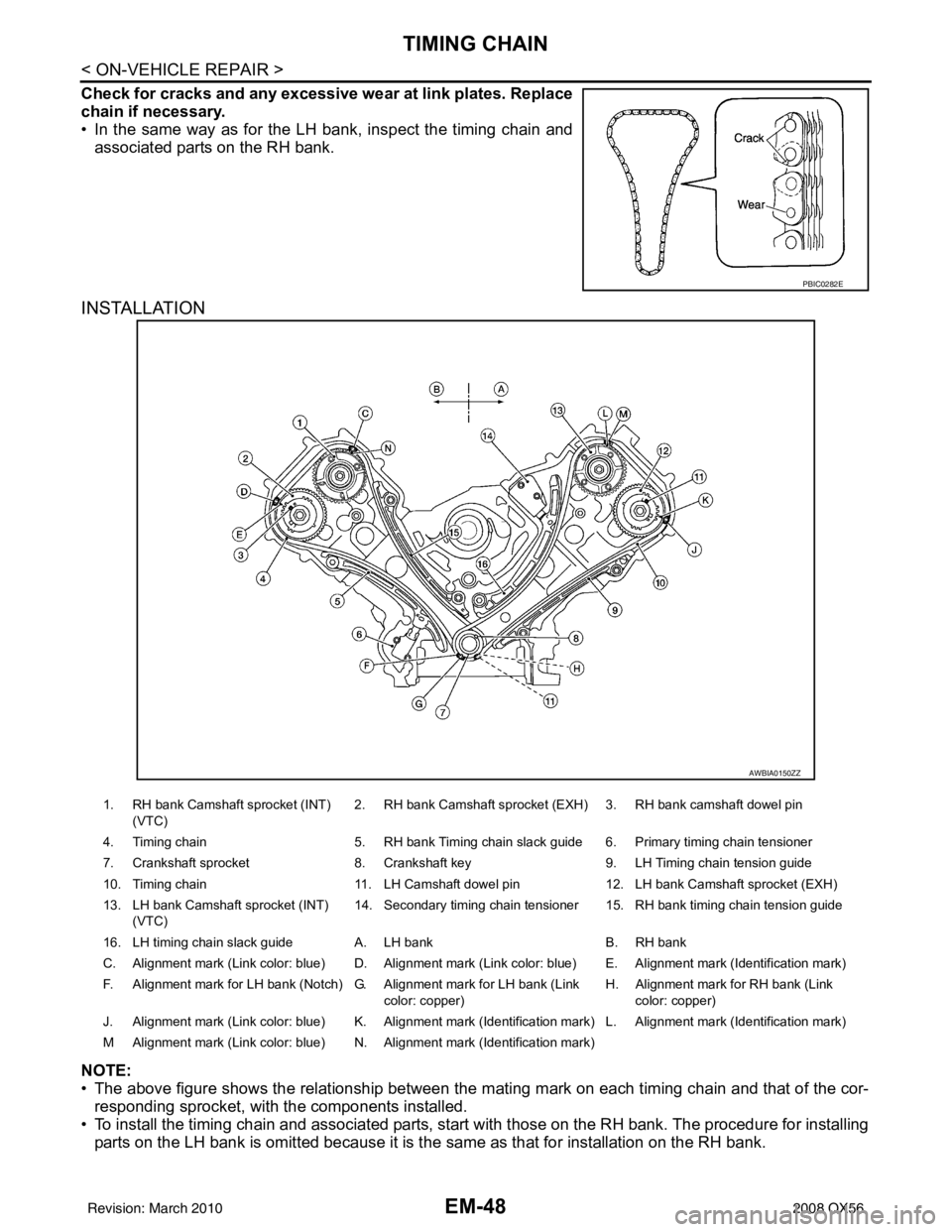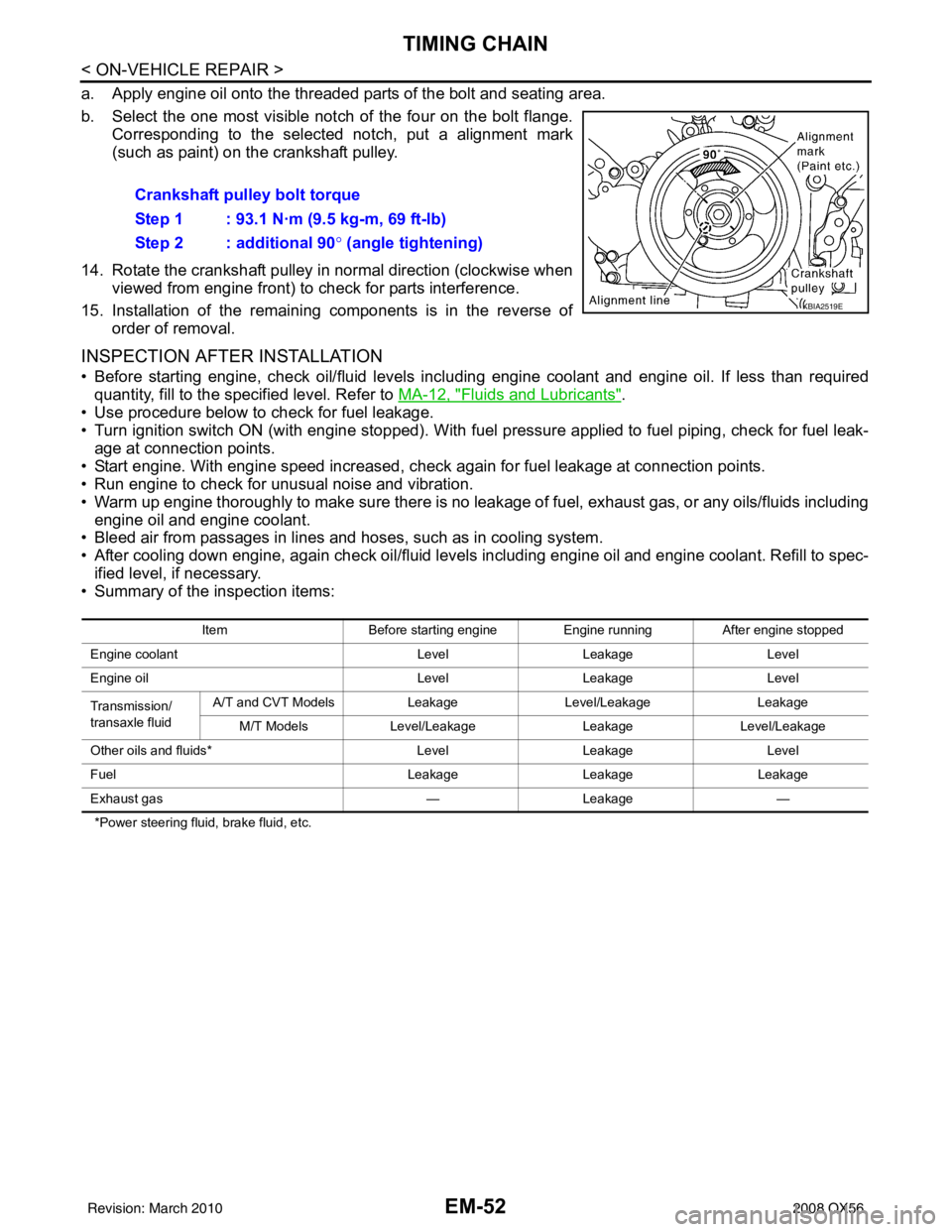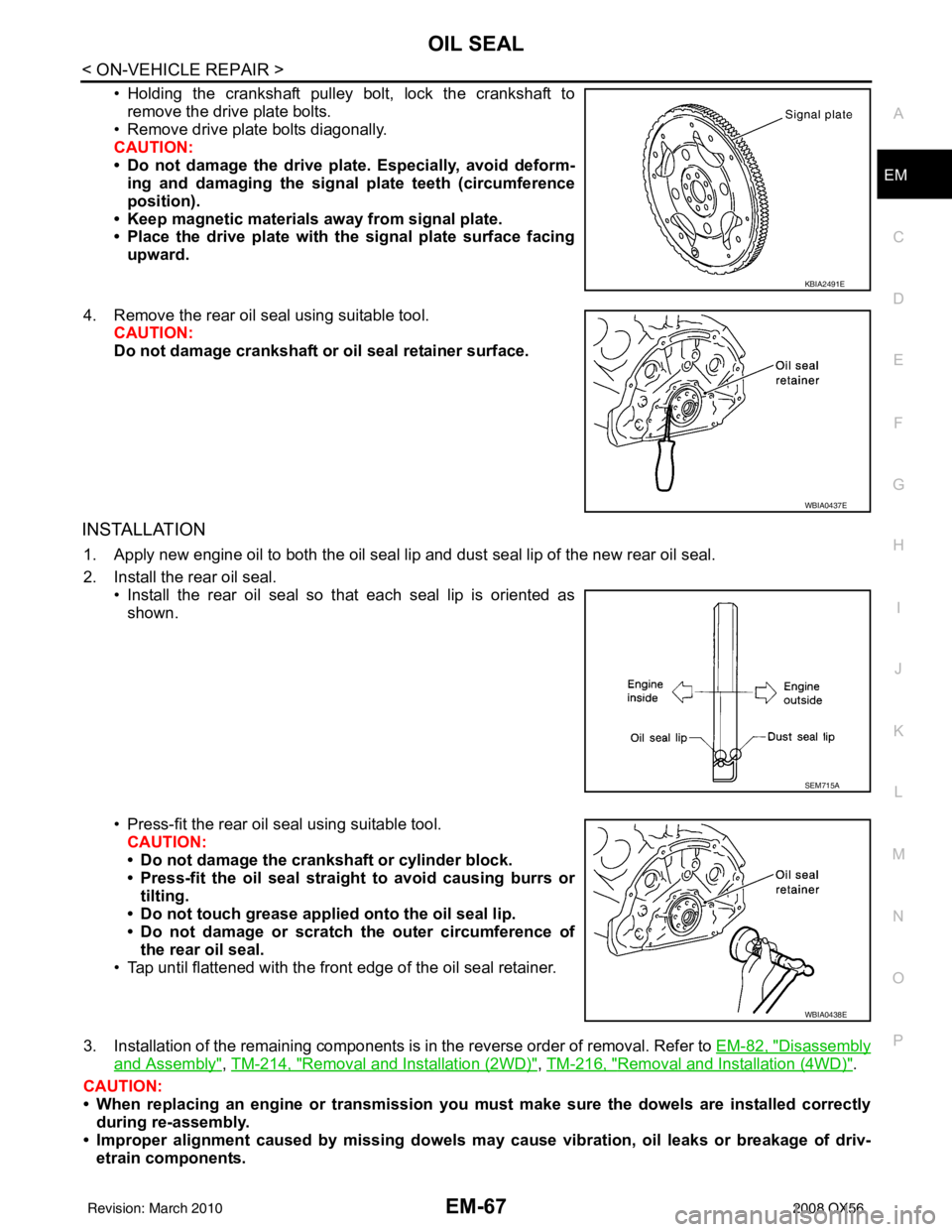2008 INFINITI QX56 ESP
[x] Cancel search: ESPPage 1770 of 4083
![INFINITI QX56 2008 Factory Service Manual ECM
EC-471
< ECU DIAGNOSIS > [VK56DE]
C
D
E
F
G H
I
J
K L
M A
EC
NP
O
• When any SRT codes are not set, MIL will flash periodically for 10 seconds.
How to Set SRT Code
To set all SRT codes, self-dia INFINITI QX56 2008 Factory Service Manual ECM
EC-471
< ECU DIAGNOSIS > [VK56DE]
C
D
E
F
G H
I
J
K L
M A
EC
NP
O
• When any SRT codes are not set, MIL will flash periodically for 10 seconds.
How to Set SRT Code
To set all SRT codes, self-dia](/manual-img/42/57030/w960_57030-1769.png)
ECM
EC-471
< ECU DIAGNOSIS > [VK56DE]
C
D
E
F
G H
I
J
K L
M A
EC
NP
O
• When any SRT codes are not set, MIL will flash periodically for 10 seconds.
How to Set SRT Code
To set all SRT codes, self-diagnosis for the items indicated above must be performed one or more times. Each
diagnosis may require a long period of actual driving under various conditions.
WITH CONSULT-III
Perform corresponding DTC Confirmation Procedure one by one based on Performance Priority in the table
on "SRT Item".
WITHOUT CONSULT-III
The most efficient driving pattern in which SRT codes can be properly set is explained on the next page. The
driving pattern should be performed one or more times to set all SRT codes.
PBIB2317E
Revision: March 2010 2008 QX56
Page 1773 of 4083
![INFINITI QX56 2008 Factory Service Manual EC-474
< ECU DIAGNOSIS >[VK56DE]
ECM
ItemOBD-
MID Self-diagnostic test item
DTCTest value and Test
limit
(GST display) Description
TID Unit and
Scaling ID
HO2S 01H
Air fuel ratio (A/F) sensor 1
(B INFINITI QX56 2008 Factory Service Manual EC-474
< ECU DIAGNOSIS >[VK56DE]
ECM
ItemOBD-
MID Self-diagnostic test item
DTCTest value and Test
limit
(GST display) Description
TID Unit and
Scaling ID
HO2S 01H
Air fuel ratio (A/F) sensor 1
(B](/manual-img/42/57030/w960_57030-1772.png)
EC-474
< ECU DIAGNOSIS >[VK56DE]
ECM
ItemOBD-
MID Self-diagnostic test item
DTCTest value and Test
limit
(GST display) Description
TID Unit and
Scaling ID
HO2S 01H
Air fuel ratio (A/F) sensor 1
(Bank 1) P0131 83H 0BH
Minimum sensor output voltage
for test cycle
P0131 84H 0BH Maximum sensor output voltage
for test cycle
P0130 85H 0BH Minimum sensor output voltage
for test cycle
P0130 86H 0BH Maximum sensor output voltage
for test cycle
P0133 87H 04H Response rate: Response ratio
(Lean to Rich)
P0133 88H 04H Response rate: Response ratio
(Rich to Lean)
P2A00 89H 84H The amount of shift in air fuel ratio
P2A00 8AH 84H The amount of shift in air fuel ratio
P0130 8BH 0BH Difference in sensor output volt-
age
P0133 8CH 83H Response gain at the limited fre-
quency
02H Heated oxygen sensor 2
(Bank 1) P0138 07H 0CH
Minimum sensor output voltage
for test cycle
P0137 08H 0CH Maximum sensor output voltage
for test cycle
P0138 80H 0CH Sensor output voltage
P0139 81H 0CH Difference in sensor output volt-
age
03H Heated oxygen sensor 3
(Bank 1) P0143 07H 0CH
Minimum sensor output voltage
for test cycle
P0144 08H 0CH Maximum sensor output voltage
for test cycle
P0146 80H 0CH Sensor output voltage
P0145 81H 0CH Difference in sensor output volt-
age
Revision: March 2010
2008 QX56
Page 1774 of 4083
![INFINITI QX56 2008 Factory Service Manual ECM
EC-475
< ECU DIAGNOSIS > [VK56DE]
C
D
E
F
G H
I
J
K L
M A
EC
NP
O
HO2S 05H
Air fuel ratio (A/F) sensor 1
(Bank 2) P0151 83H 0BH
Minimum sensor output voltage
for test cycle
P0151 84H 0BH Maximum INFINITI QX56 2008 Factory Service Manual ECM
EC-475
< ECU DIAGNOSIS > [VK56DE]
C
D
E
F
G H
I
J
K L
M A
EC
NP
O
HO2S 05H
Air fuel ratio (A/F) sensor 1
(Bank 2) P0151 83H 0BH
Minimum sensor output voltage
for test cycle
P0151 84H 0BH Maximum](/manual-img/42/57030/w960_57030-1773.png)
ECM
EC-475
< ECU DIAGNOSIS > [VK56DE]
C
D
E
F
G H
I
J
K L
M A
EC
NP
O
HO2S 05H
Air fuel ratio (A/F) sensor 1
(Bank 2) P0151 83H 0BH
Minimum sensor output voltage
for test cycle
P0151 84H 0BH Maximum sensor output voltage
for test cycle
P0150 85H 0BH Minimum sensor output voltage
for test cycle
P0150 86H 0BH Maximum sensor output voltage
for test cycle
P0153 87H 04H Response rate: Response ratio
(Lean to Rich)
P0153 88H 04H Response rate: Response ratio
(Rich to Lean)
P2A03 89H 84H The amount of shift in air fuel ratio
P2A03 8AH 84H The amount of shift in air fuel ratio
P0150 8BH 0BH Difference in sensor output volt-
age
P0153 8CH 83H Response gain at the limited fre-
quency
06H Heated oxygen sensor 2
(Bank 2) P0158 07H 0CH
Minimum sensor output voltage
for test cycle
P0157 08H 0CH Maximum sensor output voltage
for test cycle
P0158 80H 0CH Sensor output voltage
P0159 81H 0CH Difference in sensor output volt-
age
07H Heated oxygen sensor 3
(Bank2) P0163 07H 0CH
Minimum sensor output voltage
for test cycle
P0164 08H 0CH Maximum sensor output voltage
for test cycle
P0166 80H 0CH Sensor output voltage
P0165 81H 0CH Difference in sensor output volt-
age
CATA-
LYST 21H
Three way catalyst function
(Bank1) P0420 80H 01H O2 storage index
P0420 82H 01H
Switching time lag engine exhaust
index value
P2423 83H 0CH Difference in 3rd O2 sensor out-
put voltage
P2423 84H 84H O2 storage index in HC trap cata-
lyst
22H Three way catalyst function
(Bank2) P0430 80H 01H O2 storage index
P0430 82H 01H
Switching time lag engine exhaust
index value
P2424 83H 0CH Difference in 3rd O2 sensor out-
put voltage
P2424 84H 84H O2 storage index in HC trap cata-
lyst
Item
OBD-
MID Self-diagnostic test item
DTCTest value and Test
limit
(GST display) Description
TID Unit and
Scaling ID
Revision: March 2010 2008 QX56
Page 1786 of 4083
![INFINITI QX56 2008 Factory Service Manual PRECAUTIONSEC-487
< PRECAUTION > [VK56DE]
C
D
E
F
G H
I
J
K L
M A
EC
NP
O
5. When the repair work is completed, return the ignition switch to the
″LOCK ″ position before connecting
the battery ca INFINITI QX56 2008 Factory Service Manual PRECAUTIONSEC-487
< PRECAUTION > [VK56DE]
C
D
E
F
G H
I
J
K L
M A
EC
NP
O
5. When the repair work is completed, return the ignition switch to the
″LOCK ″ position before connecting
the battery ca](/manual-img/42/57030/w960_57030-1785.png)
PRECAUTIONSEC-487
< PRECAUTION > [VK56DE]
C
D
E
F
G H
I
J
K L
M A
EC
NP
O
5. When the repair work is completed, return the ignition switch to the
″LOCK ″ position before connecting
the battery cables. (At this time, the steering lock mechanism will engage.)
6. Perform a self-diagnosis check of al l control units using CONSULT-III.
On Board Diagnosis (OBD) System of Engine and A/TINFOID:0000000001351222
The ECM has an on board diagnostic system . It will light up the malfunction indicator lamp (MIL) to warn the
driver of a malfunction causing emission deterioration.
CAUTION:
• Be sure to turn the ignition switch OFF and di sconnect the negative battery cable before any repair
or inspection work. The open/short circuit of re lated switches, sensors, solenoid valves, etc. will
cause the MIL to light up.
• Be sure to connect and lock the connectors secure ly after work. A loose (unlocked) connector will
cause the MIL to light up due to the open circuit. (Be sure the connector is free from water, grease,
dirt, bent terminals, etc.)
• Certain systems and components, especially those related to OBD, may use a new style slide-lock-
ing type harness connector. For description and how to disconnect, refer to PG-65
.
• Be sure to route and secure the harnesses properly after work. The interference of the harness with
a bracket, etc. may cause the MIL to li ght up due to the short circuit.
• Be sure to connect rubber tubes properly afte r work. A misconnected or disconnected rubber tube
may cause the MIL to light up due to the malfuncti on of the EVAP system or fuel injection system,
etc.
• Be sure to erase the unnecessary malfunction information (repairs completed) from the ECM and TCM (Transmission control module) before returning the vehicle to the customer.
PrecautionINFOID:0000000006211821
•Always use a 12 volt battery as power source.
• Do not attempt to disconnect battery cables while engine is
running.
• Before connecting or disc onnecting the ECM harness con-
nector, turn ignition switch OFF and disconnect negative bat-
tery cable. Failure to do so may damage the ECM because
battery voltage is applied to ECM even if ignition switch is
turned OFF.
• Before removing parts, turn ig nition switch OFF and then dis-
connect negative battery cable.
• Do not disassemble ECM.
• If a battery cable is disconnected, the memory will return to
the ECM value.
The ECM will now start to sel f-control at its initial value.
Engine operation can vary slight ly when the terminal is dis-
connected. However, this is not an indication of a malfunc-
tion. Do not replace parts because of a slight variation.
• If the battery is disconnected, the following emission-related
diagnostic information will be lost within 24 hours.
- Diagnostic trouble codes
- 1st trip diagnostic trouble codes
- Freeze frame data
- 1st trip freeze frame data
- System readiness test (SRT) codes
- Test values
-
Presumed ethanol mixture ratio
SEF289H
PBIB1164E
Revision: March 2010 2008 QX56
Page 1826 of 4083

COMPRESSION PRESSUREEM-23
< ON-VEHICLE MAINTENANCE >
C
DE
F
G H
I
J
K L
M A
EM
NP
O
COMPRESSION PRESSURE
Checking Compression PressureINFOID:0000000001538811
1. Warm up the engine thoroughly. Then stop the engine.
2. Release the fuel pressure. Refer to EC-494, "
Fuel Pressure Check".
CAUTION:
If CONSULT-III is not used to release fuel pressure leave the fuel pump fuse disconnected until
step 7.
3. Remove the spark plug from each cylinder. Refer to EM-16, "
Removal and Installation".
4. Connect the engine tachometer (not required in use of CONSULT-III).
5. Install the compression tester with Tool into the spark plug hole.
6. With the accelerator pedal fully depressed, turn the ignition switch to “START” for cranking. When the gauge pointer stabi-
lizes, read the compression pressure and engine rpm. Perform
these steps to check each cylinder.
Unit: kPa (kg/cm2, psi) /rpm
CAUTION:
Always use a fully charged battery to obtain specified engine speed.
• If the engine speed is out of the specified range, check the battery liquid for proper gravity. Check the engine speed again with normal battery gravity.
• If the compression pressure is below the minimum value, check the valve clearances and parts associ-
ated with the combustion chamber (valve, valve seat , piston, piston ring, cylinder bore, cylinder head,
cylinder head gasket). After checking, measure the compression pressure again.
• If some cylinders have low compression pressure, pour a small amount of engine oil into the spark plug hole of the cylinder to re-check it for compression.
- If the added engine oil improves the compression, t he piston rings may be worn out or damaged. Check
the piston rings and replace if necessary.
- If the compression pressure remains at a low level despite the addition of engine oil, the valves may be malfunctioning. Check the valves for damage. Replace the valve or valve seat accordingly.
• If two adjacent cylinders have respectively low compression pressure and their compression remains low even after the addition of engine oil, the gaskets may be leaking, or a valve in adjacent cylinders
may be damaged. Inspect and repair as required.
7. Install the components in the reverse order of removal.
8. Start the engine and confirm that it runs smoothly.
9. Perform trouble diagnosis. If DTC appears, erase it. Refer to EC-75, "
Description".
Tool number : EG15050500 (J-45402)
Standard
MinimumDeference limit be-
tween cylinders
1,520 (15.5, 220) / 200 1,324 (13.5, 192) / 200 98 (1.0, 14) / 200WBIA0605E
Revision: March 2010 2008 QX56
Page 1851 of 4083

EM-48
< ON-VEHICLE REPAIR >
TIMING CHAIN
Check for cracks and any excessive wear at link plates. Replace
chain if necessary.
• In the same way as for the LH bank, inspect the timing chain andassociated parts on the RH bank.
INSTALLATION
NOTE:
• The above figure shows the relationship between the ma ting mark on each timing chain and that of the cor-
responding sprocket, with the components installed.
• To install the timing chain and associated parts, start with those on the RH bank. The procedure for installing parts on the LH bank is omitted because it is t he same as that for installation on the RH bank.
PBIC0282E
AWBIA0150ZZ
1. RH bank Camshaft sprocket (INT)
(VTC) 2. RH bank Camshaft sprocket (EXH) 3. RH bank camshaft dowel pin
4. Timing chain 5. RH bank Timing chain slack guide 6. Primary timing chain tensioner
7. Crankshaft sprocket 8. Crankshaft key 9. LH Timing chain tension guide
10. Timing chain 11. LH Camshaft dowel pin 12. LH bank Camshaft sprocket (EXH)
13. LH bank Camshaft sprocket (INT) (VTC) 14. Secondary timing chain tensioner 15. RH bank timing chain tension guide
16. LH timing chain slack guide A. LH bank B. RH bank
C. Alignment mark (Link color: blue) D. Alignment mark (Link color: blue) E. Alignment mark (Identification mark)
F. Alignment mark for LH bank (Notch) G. Alignment mark for LH bank (Link color: copper)H. Alignment mark
for RH bank (Link
color: copper)
J. Alignment mark (Link color: blue) K. Alignment mark (Identification mark) L. Alignment mark (Identification mark)
M Alignment mark (Link color: blue) N. Alignment mark (Identification mark)
Revision: March 2010 2008 QX56
Page 1855 of 4083

EM-52
< ON-VEHICLE REPAIR >
TIMING CHAIN
a. Apply engine oil onto the threaded parts of the bolt and seating area.
b. Select the one most visible notch of the four on the bolt flange.Corresponding to the selected notch, put a alignment mark
(such as paint) on the crankshaft pulley.
14. Rotate the crankshaft pulley in normal direction (clockwise when viewed from engine front) to check for parts interference.
15. Installation of the remaining components is in the reverse of order of removal.
INSPECTION AFTER INSTALLATION
• Before starting engine, check oil/fluid levels incl uding engine coolant and engine oil. If less than required
quantity, fill to the specified level. Refer to MA-12, "
Fluids and Lubricants".
• Use procedure below to check for fuel leakage.
• Turn ignition switch ON (with engine stopped). With fuel pressure applied to fuel piping, check for fuel leak- age at connection points.
• Start engine. With engine speed increased, che ck again for fuel leakage at connection points.
• Run engine to check for unusual noise and vibration.
• Warm up engine thoroughly to make sure there is no leakage of fuel, exhaust gas, or any oils/fluids including
engine oil and engine coolant.
• Bleed air from passages in lines and hoses, such as in cooling system.
• After cooling down engine, again check oil/fluid levels including engine oil and engine coolant. Refill to spec-
ified level, if necessary.
• Summary of the inspection items:
*Power steering fluid, brake fluid, etc.
Crankshaft pulley bolt torque
Step 1 : 93.1 N·m (9.5 kg-m, 69 ft-lb)
Step 2 : additional 90 ° (angle tightening)
KBIA2519E
Item Before starting engine Engine runningAfter engine stopped
Engine coolant LevelLeakage Level
Engine oil LevelLeakage Level
Transmission/
transaxle fluid A/T and CVT Models
LeakageLevel/Leakage Leakage
M/T Models Level/Leakage LeakageLevel/Leakage
Other oils and fluids* LevelLeakage Level
Fuel LeakageLeakage Leakage
Exhaust gas —Leakage —
Revision: March 2010 2008 QX56
Page 1870 of 4083

OIL SEALEM-67
< ON-VEHICLE REPAIR >
C
DE
F
G H
I
J
K L
M A
EM
NP
O
• Holding the crankshaft pulley bolt, lock the crankshaft to
remove the drive plate bolts.
• Remove drive plate bolts diagonally.
CAUTION:
• Do not damage the drive plate. Especially, avoid deform- ing and damaging the signal plate teeth (circumference
position).
• Keep magnetic materials away from signal plate.
• Place the drive plate with th e signal plate surface facing
upward.
4. Remove the rear oil seal using suitable tool. CAUTION:
Do not damage crankshaft or oil seal retainer surface.
INSTALLATION
1. Apply new engine oil to both the oil seal lip and dust seal lip of the new rear oil seal.
2. Install the rear oil seal.
• Install the rear oil seal so that each seal lip is oriented asshown.
• Press-fit the rear oil seal using suitable tool. CAUTION:
• Do not damage the crankshaft or cylinder block.
• Press-fit the oil seal straight to avoid causing burrs or
tilting.
• Do not touch grease applied onto the oil seal lip.
• Do not damage or scratch the outer circumference of
the rear oil seal.
• Tap until flattened with the front edge of the oil seal retainer.
3. Installation of the remaining components is in the reverse order of removal. Refer to EM-82, "
Disassembly
and Assembly", TM-214, "Removal and Installation (2WD)", TM-216, "Removal and Installation (4WD)".
CAUTION:
• When replacing an engine or tr ansmission you must make sure the dowels are installed correctly
during re-assembly.
• Improper alignment caused by missing dowels m ay cause vibration, oil leaks or breakage of driv-
etrain components.
KBIA2491E
WBIA0437E
SEM715A
WBIA0438E
Revision: March 2010 2008 QX56